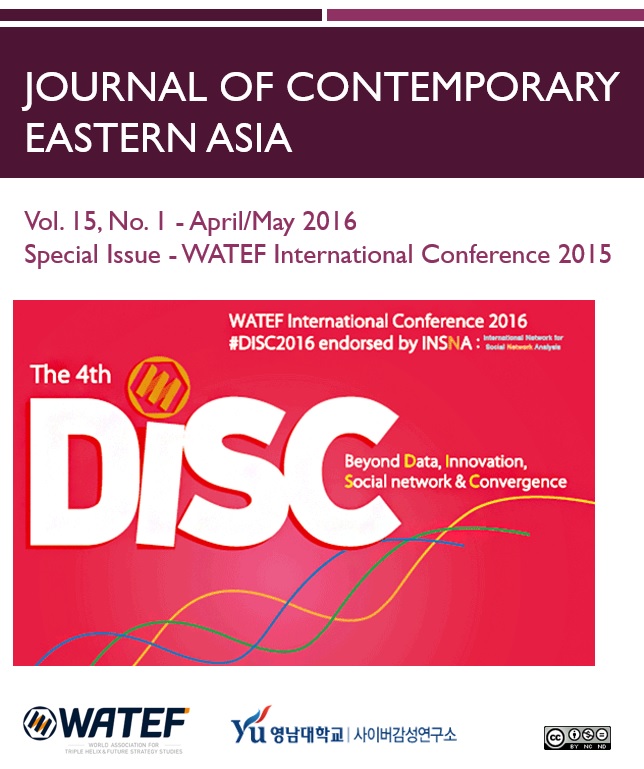- KOREAN
- E-ISSN2383-9449
- SCOPUS
 E-ISSN : 2383-9449
E-ISSN : 2383-9449
Tkach-Kawasaki, Leslie
Kobashi, Yohei
Hartwig, Manuela
Tsujinaka, Yutaka
Abstract
Energy policy is known to have higher path dependency among policy fields (Kuper and van Soest, 2003; OECD, 2012; Kikkawa, 2013) and is a critical component of the infrastructure development undertaken in the early stages of nation building. Actor roles, such as those played by interest groups, are firmly formed, making it unlikely that institutional change can be implemented. In resource-challenged Japan, energy policy is an especially critical policy area for the Japanese government. In comparing energy policy making in Japan and Germany, Japan’s policy community is relatively firm (Hartwig et al., 2015), and it is improbable that institutional change can occur. The Japanese government’s approach to energy policy has shifted incrementally in the past half century, with the most recent being the 2012 implementation of the “Feed-In Tariff Law” (Act on Special Measures Concerning Procurement of Renewable Electric Energy by Operators of Electric Utilities), which encourages new investment in renewable electricity generation and promotes the use of renewable energy. Yet, who were the actors involved and the factors that influenced the establishment of this new law? This study attempts to assess the factors associated with implementing the law as well as the roles of the relevant major actors. In answering this question, we focus on identifying the policy networks among government, political parties, and interest groups, which suggests that success in persuading key economic groups could be a factor in promoting the law. Our data is based on the “Global Environmental Policy Network Survey 2012-2013 (GEPON2)” which was conducted immediately after the March 11, 2011 Great East Japan Earthquake with respondents including political parties, the government, interest groups, and civil society organizations. Our results suggest that the Feed in Tariff (FIT) Law’s network structure is similar to the information network and support network, and that the actors at the center of the network support the FIT Law. The strength of our research lays in our focus on political networks and their contributing mechanism to the law’s implementation through analysis of the political process. From an academic perspective, identifying the key actors and factors may be significant in explaining institutional change in policy areas with high path dependency. Close examination of this issue also has implications for a society that can promote renewable and sustainable energy resources.
- keywords
Reference
Kikkawa, T.;. Japan’s Energy Problems (Nihon no enerugĩ mondai).
Gerard, K.;van Soest, D. P.;. (2003). Path-dependency and input substitution: implications for energy policy modeling. Energy Economics, 25, 397-4-7. 10.1016/S0140-9883(02)00098-1.
Manuela, Hartwig;Yohei, Kobashi;Sae, Okura;Leslie, Tkach-Kawasaki;. (2015). Energy Policy Participation through Networks Transcending Cleavage: an Analysis of Japanese and German Renewable Energy Promotion Policies. Quality and Quantity, 49(4), 1485-1512. 10.1007/s11135-014-0093-9.
Heclo, H.;editor King A.;. The New American Political System;Issue Networks and the Executive Establishment.
Kobashi, Y.;Tsujinaka, Y.;. Global Environmental Policy Network Survey, 2 (GEPON 2): An Interim Report.
Kubo, H.;editor Shiroyama H.;editor Yamamoto R.;. Dissolving Borders, Transcending Law 5 Environment and Life (Tokeru sakai koeru hou 5 kankyō to seimei);“Domestic Policy implementation and Process for Treaty for the Protection of the Ozone Layer: Evidence from Activities of Domestic Companies (Ozon sō hogo jōyaku no kokunai jisshi taisei to katei: Kokunai jijōsha no torikumi ni shōten wo atete)”.
Berkhout, F.;. (2002). Technological regimes, path dependency and the environment. Global Environmental Change, 12, 1-4. 10.1016/S0959-3780(01)00025-5.
Foljanty-Jost, G.;. (2005). NGOs in environmental networks in Germany and Japan: The question of power and influence. Social Science Japan Journal, 8(1), 103-117. 10.1093/ssjj/jyi019.
Kubo, H.;editor Morita A.;editor Kanai T;. Shifts in Policies and Institutional Design: The administration around Realignment of Politics and Ministries (Seisaku henyou to seido sekkei: seikai shōchō saihen zengo no gyōsei:;“Global Environmental Policy: Shifts in Climate Change Policy and Realignment of Politics and Ministries (Chikyū kankyō seisaku: Ondanka taisaku no henyō to seikai saihen shōōchō saihen)”.
Morita, A.;. Administration in Modern Japan (Gendai no gyōsei):.
OECD. OECD Green Growth Studies: Energy.
Okumura, N.;. (2007). Path dependency, lock-in and the economy of global energy strategies (Keiro izon, rokku in to gurōbaru enerugī senryaku). Energy Economics, 33(2), 33-39.
Watanabe, R.;. Climate Policy Changes in Germany and Japan: A Path to Paradigmatic Policy Change.
Smith, M. J.;. (1991). From Policy Community to Issue Network: Salmonella in Eggs and the Politics of Food. Public Administration, 69, 235-255. 10.1111/j.1467-9299.1991.tb00792.x.
- Downloaded
- Viewed
- 0KCI Citations
- 0WOS Citations
